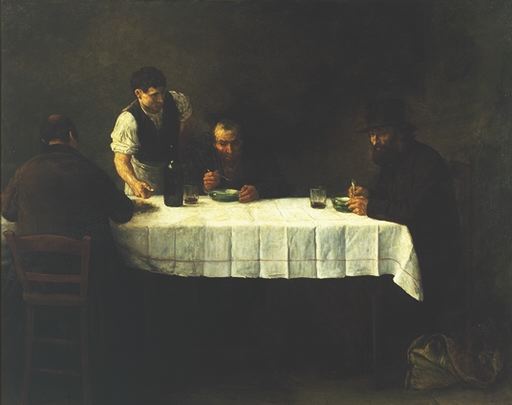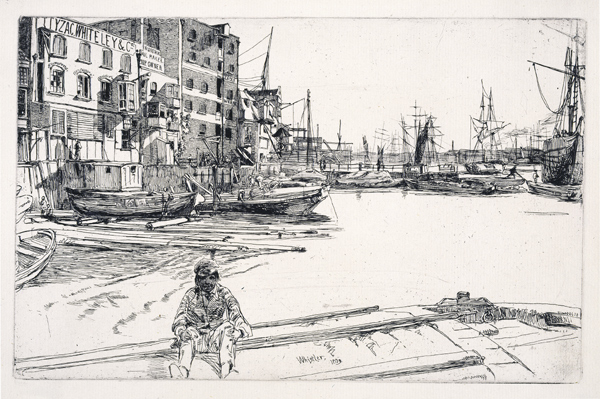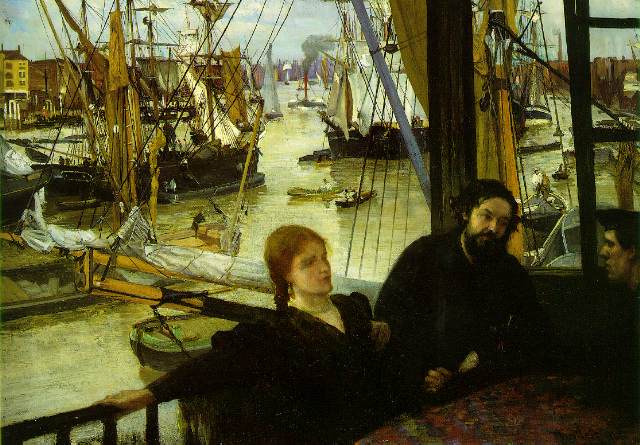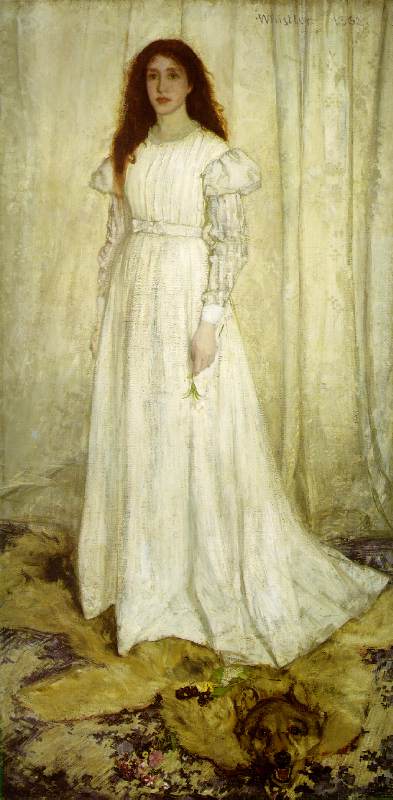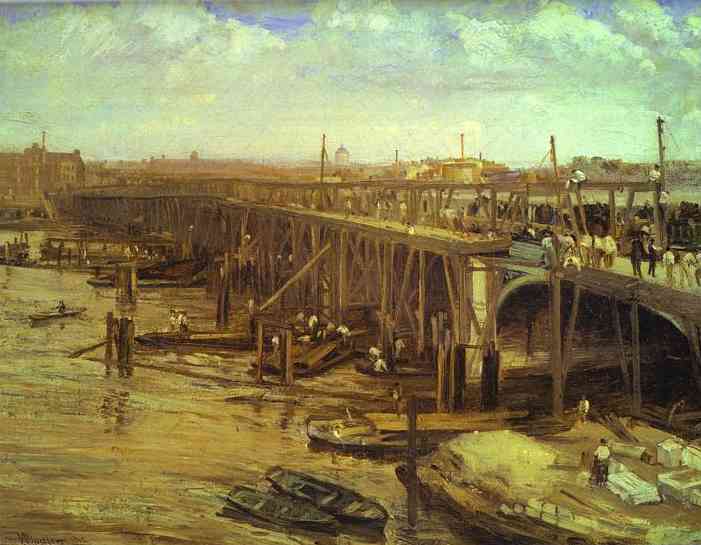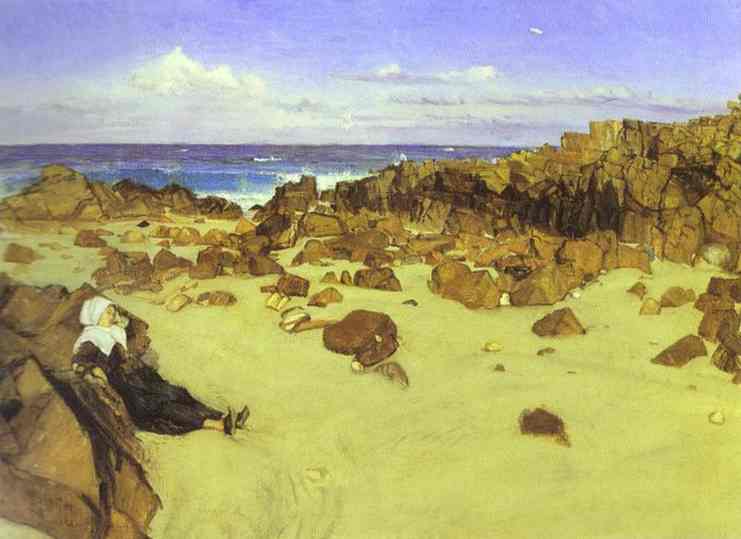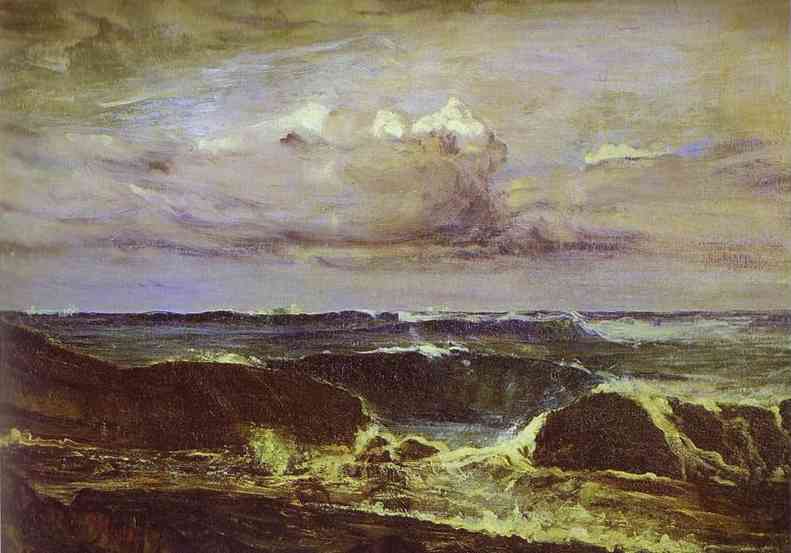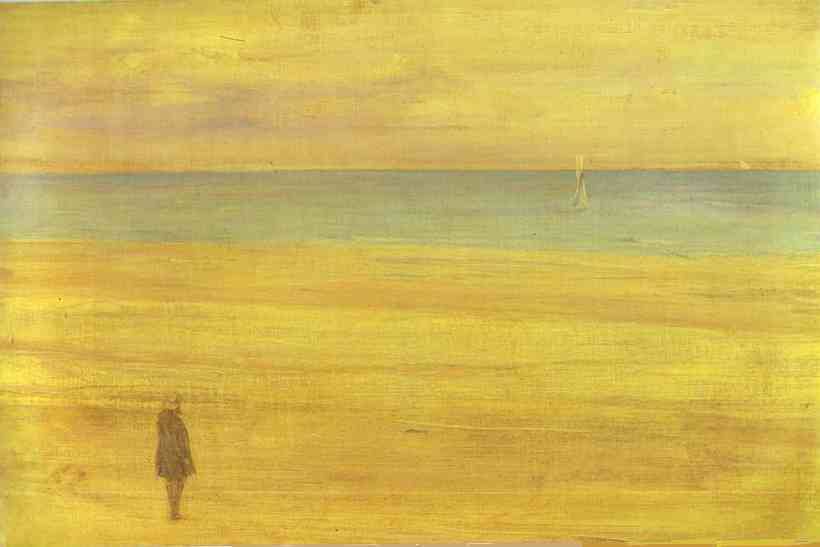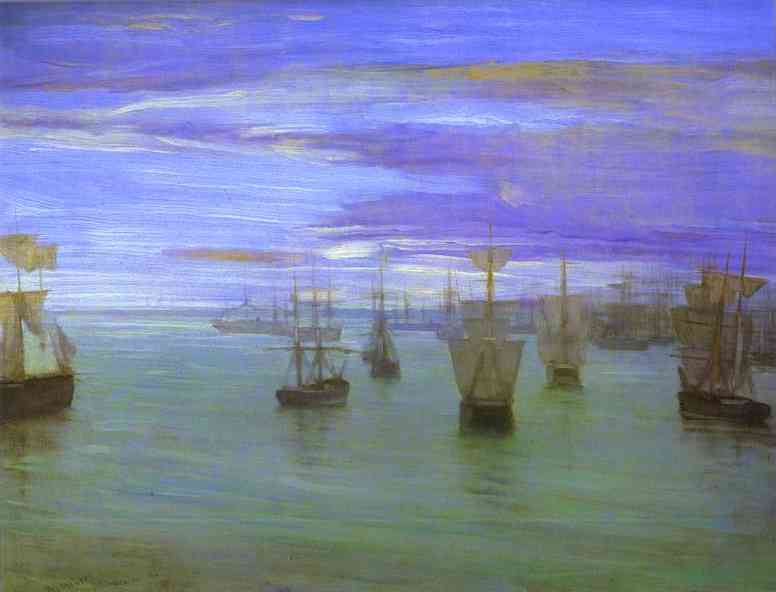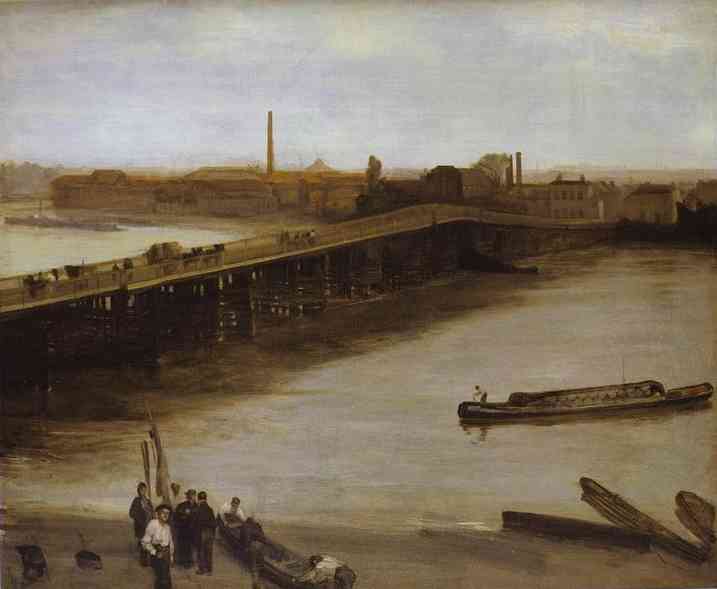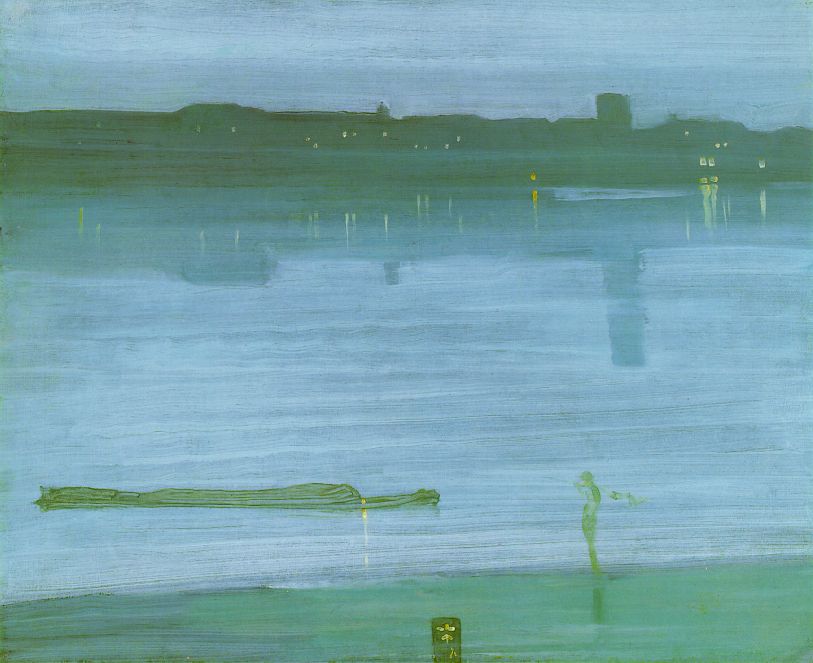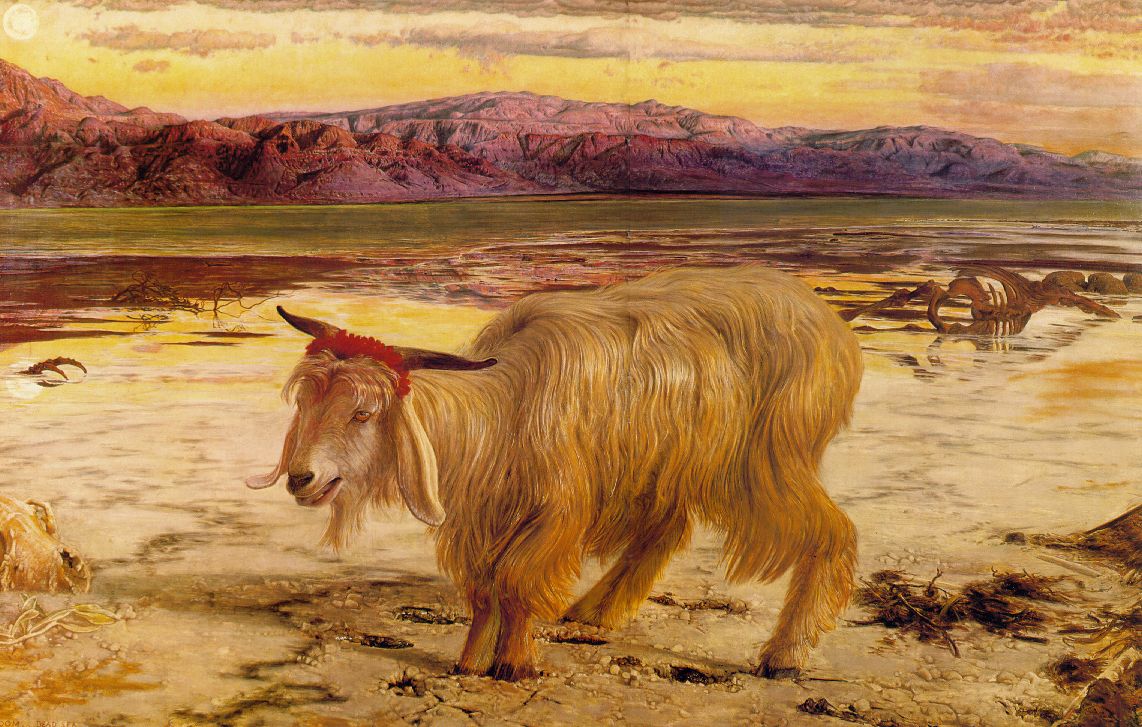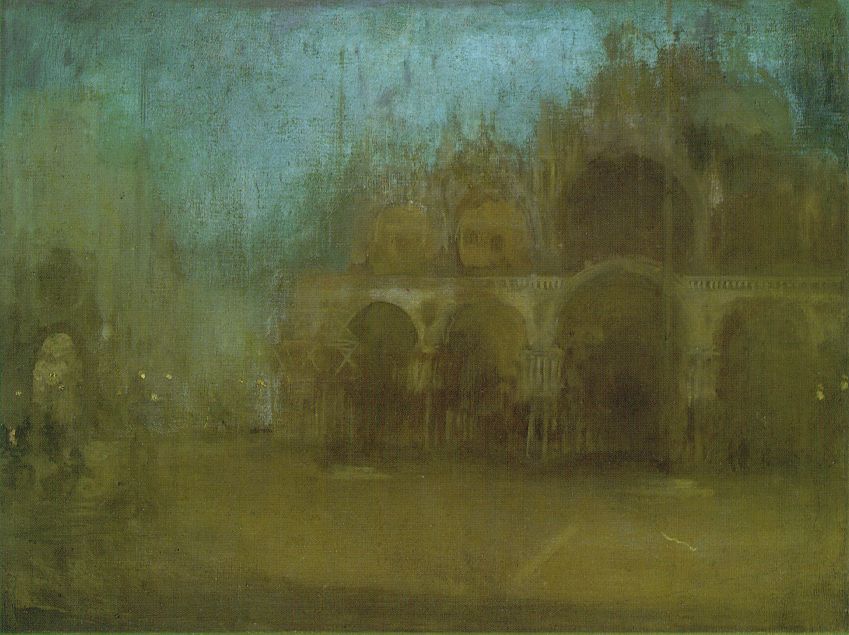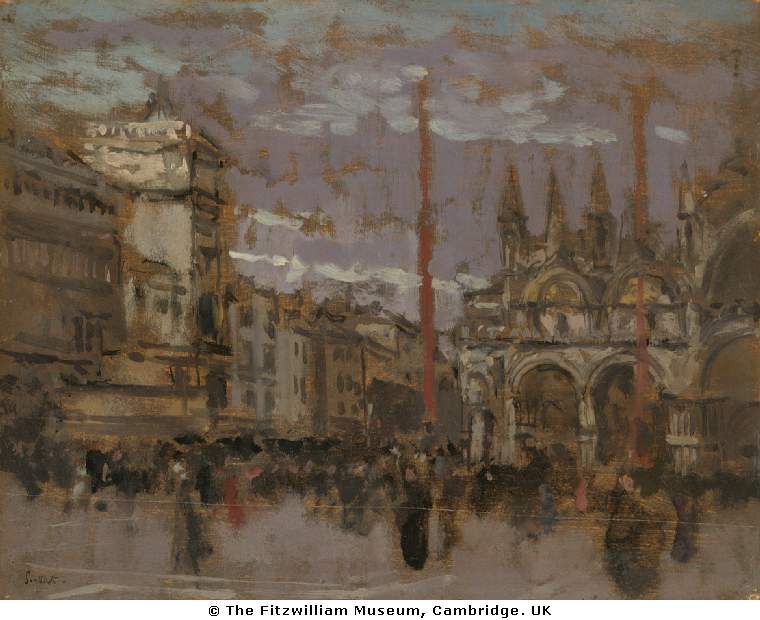Whistler
We will talk about escaping from urbanism starting with Whistler (see the
catalogue Turner, Whistler, Monet it has a comprehensive analysis of Whistler).
Escape and the relationship between Englsih and French art.
There was a French set in London, one was Legros, a follower of Courbet (like
Bastian Lepage).
Legros, Le Repas des Pauvres, 1877. Settled in London in 1863, a friend of Manet,
Degas and Whistler he became the main link between the French and English avant
garde.
He became a Professor at the Slade (founded 1868, first Slade Professor Sir
Edward Poynter, from 1876 Alphonse Legros was Slade Professor to 1892). It was
founded to stop artists going to Paris to train in French ateliers (read Daphne
du Maurier Trilby (introduces Svengali) as it is about English students in
French ateliers). Paul Durand-Ruel (see
Durand-Ruel),
dealer, exhibited French paintings in London.
James McNeill Whistler (1834-1903, see
Whistler), a
Russian American trained at West Point, then Holland and Paris and settled in
London in 1859 for the rest of his life.
Henry James was also interested in to-ing and fro-ing between Paris and London
as did Whistler. They were the two biggest capitals in Europe, near each other
and had similar social issues. (Hunt thought Napoleon III was like we regard
Osama bin Laden but he visited Paris and even went ot see the Can-Can with
Rossetti, so there was a mixed reaction to things French.)
Whistler took rooms in Wapping (like Toxteth today?). East London was almost
like a foreign country, people talked about going there to do missionary work as
if it was part of the Congo. Why did Whistler go there? Did he want to go to a
provincial, poor, “primitive” area? He stayed four years (going backwards and
forwards to Paris) before he moved to Chelsea.
Whistler’s etchings “Thames Set” (see
Whistler’s Thames Set), 1860s.
James McNeill Whistler, born United States of America 1834 died England 1903,
Eagle Wharf from the Thames set 1859, intaglio print, plate 13.6 x 21.4 cm,
sheet 16.0 x 23.8 cm, Collection of the National Gallery of Australia.
He was also making etchings in France of peasant subjects. A search for
authenticity and realism. Why the city? An early interest in modernity?
Wapping, 1860-4
The Angel, Rotherhithe, with Joanna who became his mistress (Stanhope also
painted a woman gazing across the river). One of the men is Legros.
Joanna crops up in Symphony in White No. 1 (she went off with Courbet at this
time) exhibited with Dejeuner sur l’Herbe at the Salon de Refuse in 1865.
Whistler, the Last of the Old Westminster, 1862 (the bridge Turner painted on
fire). Ths year he got friendly with the Chelsea set that included Dante
Rossetti and Algernon Swinburne. In 1863 he moved to Chelsea. This is when he
rethinks and he stops being able to sell his paintings for the rest of his life.
The Coast of Brittany, 1861, painting seascapes.
Whistler, Blue and Silver: The Blue Wave Biarritz, 1862, could be a Courbet.
Did he come to London to get away from the dominant Courbet?
Beauty and Art, Prettejohn (Professor of Fine Art, Bristol) is a good book.
It explains the sophistication with which the Pre-Raphaelites were thinking
about art and shows the role of Baudelaire and Victor Cousin. Ideas were adapted
from Germany about art, beauty and the aesthetic. Aesthetics raised by Goethe
and put on the agenda by Kant. A visual quality, an experience of beauty through
ideas. Related to our notion of the sublime. Victor Cousin came up with “L’art
pour l’art”, ark for its own sake, because of the aesthetic experience. In
England they remove religion and return to Kant’s ideas. What would art be like
if we emptied it of everything except art? (was Ruskin annoying them?) They
reacted against art having a moral content. It became a formalist idea
(significant form) with Roger Fry (you can like Giotto even if you are not a
Christian).
Alter Pater came up with “art for art’s sake”. The whole 20th century was
then spent thinking art could be reduced to formal values and we lost the 19th
century analysis of art’s moral role, hard work, etc.
(If something is anti-something it is almost a comment on that thing.) Art
history is being rewritten at the moment and it could be very different in a few
years.
Symphony in Wite – the idea is that music is a model for art as it is
subjectless, 1862. Whistler wrote a letter saying it was not related to the then
famous Woman in White by Wilkie Collins. It did not go down well at the Academy
but had a better reception at the Salon de Refuse. We see a dreaming girl,
perhaps a bride, there a many associations (like music). Similar work was being
done by Leighton and Rossetti.
Harmony in Blue and Silver, Trouville, 1865.He was moving towards
monotone as he is simplifying the mood to give a much stronger emotional feeling
(the gold colour is closer to silver in the original).
Crepuscule Valparaiso, 1866. (See
Crepuscule). A bit of a crisis. Thinking of landscape in a new way.
Arrangements of boats is separate, drifting. Are the ships at sail and on a
collision course? He is now choosing dawns and sunsets. Becoming associated with
Mallarm' sunset (see handout for poem).
Brown and Silver, Old Battersea Bridge, 1859-65. Pollution is causing the
lighting effect. Definition turns to ambiguity. Vagueness is written about by
Baudelaire as a way to peak your emotions rather than definiteness. He liked
minute detail, flecks of light, figures.
Influenced by Japanese, Hokusai’s Manga Book, 1814 was owned by Whistler
Nocturne: Blue and Silver – Chelsea, 1871. Musical terms that don’t tell a story
and are self-sufficient.
(His monogram is a butterfly that looks like a “W”) Nocturnes were painted in
his studio (he knows the Thames well by this stage). Memory gives and emotional
colour (Baudelaire).
Modernity has the sense of the moment, a glimpse. The brushstrokes give a
sense of transience. Facture. Also see Walter Greaves and Paul Maitland.
Marginal character, ghostly, margins of society, suicide? Fishing? Japanese
prints? The block is a church in this picture. It could almost be a watercolour
but is painted using Whistler’s soup of thinned oil paint. It is painted on
wood. Everything is to suggest, create associations, poetic, music. Note the
simple brushstrokes. Dusk, river of life, eternity, death.
Whistler thought only certain people (“artists”) could transmit these ideas.
This leaves unsaid if only certain people could receive these ideas, this was
later picked up by Stephen Fry (“you either get modern art or you don’t”).
In 1871 Monet came to London to escape being called up. The poeticization of
the Thames by WHistler puts the Monet paintings into perspective.
Puvis de Chavannes. The Symbolists. Baudelaire is their hero and Mallarm'.
Lonely figures, monotone, affect.
Whistler drawing of Mallarm'. See the Mallarm' poem – sliding, gliding,
dreaming, memory.
Note the detail of the mountains and how this has been replaced by the loose
brushwork of Whistler.
The famous court case of 1877 must be mentioned. A new gallery opened, the
Grosvenor, and it became the main gallery for Rossetti and Burne Jones. Whistler
exhibited and Ruskin described the painting as a paint pot flung in the public’s
face. Ruskin really objected to how quickly (which is still and issue today for
some people) the the painting was painted.
Subjectless, not ennobling, docks, margins, warehouses, fireworks (metaphor
for vanity and transience), fleeting, vain, transient. Cremorne Gardens was not
a noble place.
Whistler had no money at this time as he was not selling but he still took
Ruskin to court. His defence was his years and years of perfecting his
technique, the knowledge of a lifetime. The court was notan appropriate
place to answer the question.
Harmony of colour, not about anything, no moral purpose.
Whistler was the great self-publicist (he and Oscar Wilde, in fact which of
them was the head of the Symbolist movement was argued about). He encouraged
followers. Put in charge of the Society of Artists. Encouraged Monet to come
over. 1885 gave the 10 o’clock lectures, then published the lectures which are
about his philosophy of art. He transformed the way paintings were displayed at
Grosvenor art gallery (grey room, then yellow). He also did interior design
including his own house but he had to sell after the court case so it is lost.
He is associated with the artists Godwin.
To expect and artist to just paint nature is like asking a painist to play
all the notes on a piano, an artist mst pick and choose.
Spent later life in Venice, he was sent by the Fine Art Society. Worked in
many mediums, such as etchings and pastels.
Nocturne, Blue and Gold, St. Marks, 1879-80.
Sickert, St. Marks, 1901-2. They painted together in St. Ives and Dieppe,
Whistler influenced Sickert, introduced him to Degas, and they painted together
in Venice.
References
Whistler

